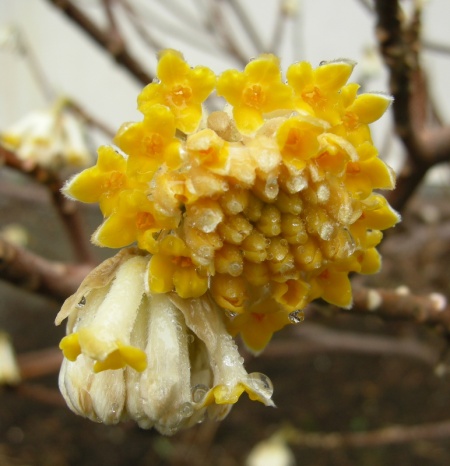Carolyn’s Shade Gardens is a retail nursery located in Bryn Mawr, PA, specializing in showy, colorful, and unusual plants for shade. The only plants that we ship are snowdrops and miniature hostas. For catalogues and announcements of events, please send your full name, location, and phone number (for back up use only) to carolyn@carolynsshadegardens.com. Click here to get to the home page of our website for catalogues and information about our nursery and to subscribe to our blog.
 ‘Early Amethyst’ beautyberry, Callicarpa dichotoma
‘Early Amethyst’ beautyberry, Callicarpa dichotoma
For fall and winter ornamental interest, you can’t beat berries. They are incredibly showy and last much longer than flowers. They attract birds to my garden when they come in flocks to feast on the bounty—sometimes sooner than I would like. And this year seems to be the best year ever for fruit production. All my berry producing plants are loaded. Is it because of all the rain we had this summer? Or does it portend a hard winter like the presence of lots of acorns? Who knows, but I am enjoying them and want to share some of my favorites with you.
.
 ‘Red Sprite’ winterberry holly, Ilex verticillata
‘Red Sprite’ winterberry holly, Ilex verticillata
.
.
Winterberry holly is a must for fall interest. It is a native deciduous holly that grows in sun to part shade and is salt and wet site tolerant. Just remember that like all hollies, it requires a male and female plant to produce fruit. ‘Red Sprite’ is more compact than most winterberries at five feet tall and four feet wide, it never needs pruning. My plants drape down over the wall of one of my terraces and are stunning this time of year. ‘Red Sprite’ produces more profusely than most winterberries, and its berries are larger and very showy. Unfortunately the robins know this too, and they sweep in and strip the bush in one day.
.
.
 The fruit clusters of Callicarpa dichotoma, an Asian native, are held away from the branch on a stalk, whereas the fruit of C. americana (photo below) surrounds the branch.
The fruit clusters of Callicarpa dichotoma, an Asian native, are held away from the branch on a stalk, whereas the fruit of C. americana (photo below) surrounds the branch.
.
The fruit of beautyberries, both native and non-native, is such a striking purple color that it stops people in their tracks. I have written about ‘Early Amethyst’ before in Woody Plants for Shade Part 3 so you can go there for all the details. ‘Early Amethyst’ is a much more fine-textured plant than the American native and fits well in a mixed border. In the last few years, I have cut my plants back to 12 to 24″ in the spring, and they have grown back to produce a 5 to 6′ plant with a beautiful habit (see top photo).
.
.
.
No, hardy begonias do not produce fruit. But the persistent seed pods and pink stems remain quite ornamental after the flowers drop off. They decorate my whole back hillside. For more information on hardy begonias, read this post Hardy Begonias for Fall Color.
.
 ‘Winter King’ green hawthorn, Crataegus viridis
‘Winter King’ green hawthorn, Crataegus viridis
.
.
I have had my ‘Winter King’ hawthorn for over 15 years, and it has never produced like this. It has a prime position outside my living room windows, and the view is amazing. Green hawthorn is a native plant adaptable to many locations and soil types. ‘Winter King’ is said to reach 30′ tall and 25′ wide in sun to part sun, although my mature plant is smaller. In the spring, fluffy white flowers cover the tree, and its silver bark is also attractive. ‘Winter King’ is a Pennsylvania Horticultural Society gold medal plant. For more information, read the PHS write up.
.
 American beautyberry, Callicarpa americana, it is difficult to get a good distance shot of the fruit when the leaves are still on. However, they will drop shortly and the berries will persist.
American beautyberry, Callicarpa americana, it is difficult to get a good distance shot of the fruit when the leaves are still on. However, they will drop shortly and the berries will persist.
.
 The fruit of American beautyberry surrounds the branch.
The fruit of American beautyberry surrounds the branch.
.
I have been looking for American beautyberry to add to my garden for almost 20 years and just installed three shrubs last fall. Although I have the Asian variety and like it, there is something about the color (blackberry purple?) and placement of the larger berries on the American variety that I find more attractive. As with a lot of North American plants, it is less refined and bigger than its Asian counterpart so not suitable for a mixed border. For more information, go to Woody Plants for Shade Part 9.
.
 ‘Amethyst’ coral berry, Symphoricarpos x doorenbosii, I must have taken 25 photos in an attempt to show you how beautiful this shrub is even from a distance but could not get one that does it justice.
‘Amethyst’ coral berry, Symphoricarpos x doorenbosii, I must have taken 25 photos in an attempt to show you how beautiful this shrub is even from a distance but could not get one that does it justice.
.
.
New to me this fall, ‘Amethyst’ coral berry has everything I am looking for in a shrub. It is a cross between two Pennsylvania native shrubs, and it grows to 3 to 5′ tall with a similar spread in part shade but is full shade tolerant. It is deer resistant and the gorgeous and unusual bright pink berries are attractive to birds. For more information, go to Woody Plants for Shade Part 9.
.
I have highlighted just a few of the plants that are making my fall garden as enjoyable as my spring display. Enjoy the remaining warm days of fall and pray for rain. Meanwhile, all new plantings and drought susceptible established plants should be watered deeply twice a week.
Carolyn
.
Carolyn’s Shade Gardens is a retail nursery located in Bryn Mawr, Pennsylvania, U.S., zone 6b. The only plants that we mail order are snowdrops and miniature hostas and only within the US.
If you are within visiting distance and would like to receive catalogues and information about customer events, please send your full name and phone number to carolynsshadegardens@verizon.net. Subscribing to my blog does not sign you up to receive this information.
Nursery Happenings: Carolyn’s Shade Gardens is closed for the winter. Look for the 2014 Snowdrop Catalogue in early January.
Facebook: Carolyn’s Shade Gardens has a Facebook Page where I post single photos, garden tips, and other information that doesn’t fit into a blog post. You can look at my Facebook page here or click the Like button on my right sidebar here.
Notes: Every word that appears in orange on my blog is a link that you can click for more information. If you want to return to my blog’s homepage to access the sidebar information (catalogues, previous articles, etc.) or to subscribe to my blog, just click here.






























